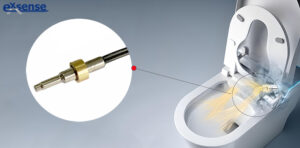NTC temperature sensor Intelligent Temperature Control: The Safety Shield for Smart Toilet Air Outlets
 Amid global economic growth and rising consumer demand, smart toilets have transitioned from luxury items to essential bathroom fixtures. Modern iterations integrate multifunctional modules—such as seat heating, automatic cleansing, and warm-air drying—to deliver comprehensive comfort. The NTC (Negative Temperature Coefficient) temperature sensor in the drying system serves as the core thermal control component. Through real-time monitoring and feedback control, it not only maintains air temperature within the optimal human comfort range (25-32°C) but also establishes a dual-layer safety mechanism. Understanding its working principles, role, and selection criteria reveals how this technology enhances convenience and safety.
Amid global economic growth and rising consumer demand, smart toilets have transitioned from luxury items to essential bathroom fixtures. Modern iterations integrate multifunctional modules—such as seat heating, automatic cleansing, and warm-air drying—to deliver comprehensive comfort. The NTC (Negative Temperature Coefficient) temperature sensor in the drying system serves as the core thermal control component. Through real-time monitoring and feedback control, it not only maintains air temperature within the optimal human comfort range (25-32°C) but also establishes a dual-layer safety mechanism. Understanding its working principles, role, and selection criteria reveals how this technology enhances convenience and safety.
Ⅰ.Working Principle of Smart Toilet Air Heating
After toilet use, internal sensors detect user presence and signal the control unit. Post-cleansing, the air circulation system activates:
- Heating elements rapidly warm incoming air to preset temperatures.
- Stabilized airflow is then delivered to evaporate residual moisture.
Here, proximity sensors and NTC temperature sensors form a collaborative safety network:
- Proximity sensors track user distance and orientation to optimise airflow direction.
- NTC sensors leverage millisecond-level responsiveness to monitor duct temperature, preventing overheating hazards.
Ⅱ.Temperature Control: How NTC Sensors Operate
Positioned at the heater outlet, the NTC sensor and heating module comprise the core thermal control unit. Its dual functions:
- Constant Temperature Control: Precision Comfort Loop
- Human comfort requires an air temperature of 25–32 °C. The NTC sensor:
- Samples temperature 10+ times per second.
- Converts thermal data to resistance values and electrical signals.
- Corrective actions:
- Under-temperature: Boosts heater power.
- Over-temperature: Reduces power/fan speed.
- PID algorithmlimits fluctuations to ±0.3°C, ensuring stable drying.
- Safety Protection: Multi-Tiered Safeguards
- With 42°C as the critical threshold:
- Stage 1: NTC detects near-threshold temps → triggers heater power reduction.
- Stage 2(if the temperature rises further):
- Audible/visual alarms activate.
- The heater power was forcibly cut off.
- Cool-air mode engages to rapidly lower outlet temperature.
- This three-stage protectionexecutes a complete shutdown within 1 second, eliminating scald risks.
Ⅲ.NTC Sensor Selection Guidelines
Sensor choice has a direct impact on performance and safety. Three critical criteria:
|
Requirement | Rationale | |
| Accuracy | ±1% tolerance (≈±0,3°C control) | Prevents discomfort/scalding; ensures thermal stability. | |
| Response Time | ≤0.8 seconds (ideal: ≤0.3 seconds) | Avoids lag-induced temperature spikes; enhances user experience during setting changes. | |
| Durability | SUS304/SUS316 stainless steel housing |
Withstands 95% RH humid environments; resists corrosion for 5,000+ hours |
Example: EXSENSE’s metal-probe sensors achieve 0.3s response times via optimized electrode/thermal design.
Conclusion
The NTC temperature sensor is indispensable in smart toilets—it guarantees comfort through precision thermal management while mitigating safety risks. Strategic sensor selection elevates user experience, reduces maintenance costs, and strengthens product competitiveness.













